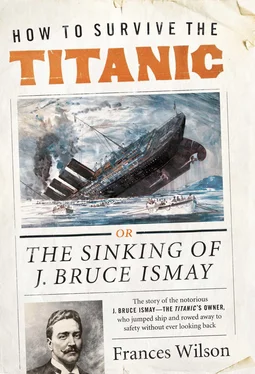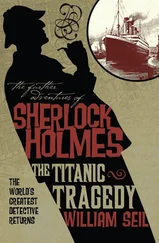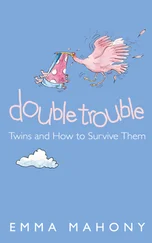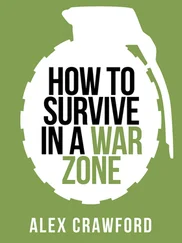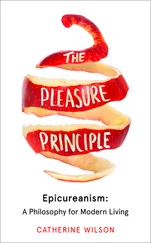‘How do you know it came?’ asked Smith.
‘Because I saw it,’ replied Lightoller. At one o’clock on Sunday, the Captain had shown it to him.
Lightoller’s cocky responses during the five hours he was questioned were designed to ridicule Smith’s pretence at authority. He thought the inquiry, as he put it in his memoirs, a ‘complete farce wherein all the traditions and customs of the sea were continuously and persistently flouted’. It was an outrage that professional seamen should answer, before their clothes had even dried, to what he called ‘an armchair judge’ who had never himself ‘been called upon to make a life-and-death decision in a sudden emergency’. 5
What mattered to Lightoller was the forthcoming British inquiry; this American affair was an amateur theatrical which had to be endured. Asked at what time he left the ship, Lightoller replied that he didn’t leave it, that the ship had left him. He kept a straight face when, in an account of how the ship’s forward funnel had fallen on top of a group of struggling swimmers, Smith inquired whether any of them were injured (one of the passengers probably killed by the funnel was John Jacob Astor, whose body, when it was found by the recovery ship, Mackay-Bennett, floating in the Atlantic, was so crushed and charred that it could be identified only by the $2,440 in notes in his pocket and the diamond ring on his finger).
In a remark which was then hard for him to live down, Smith suggested to Lightoller that some of the passengers might, as a ‘last resort’, have tried to keep dry in the Titanic ’s watertight compartments. ‘Is that at all likely?’ Smith asked.
‘No sir,’ said Lightoller. ‘Very unlikely.’
William Alden, who had by no means finished with Lightoller, was afterwards known by the British press as Watertight Smith.
After Lightoller’s testimony, Ismay left the room and paced the corridors of the Waldorf-Astoria smoking cigarettes. He was joined by journalists who badgered him as to whether he had left a ship filled with women and children. The inquiry, Ismay responded in a rage of indignation, was ‘horribly, horribly unfair. I cannot understand it.’ He spoke to the press — whom he knew to be conducting a trial of their own — as he had been unable to speak to Smith. Ismay, who had never before made a speech, was now fighting for his life:
What sort of man do you think I am? Do you believe I’m the sort who would have left the ship as long as there were any women and children aboard her? I think it was the last boat that was lowered I went into. I did then what any other passenger would do. And tell me how I was different from any other passengers? I was not running the ship. If they say I was the president of the company that owns the ship then I want to know where you will draw the line. As I lay in my stateroom on board the Carpathia I went over every detail of the affair. I have searched my mind with deepest care. I have thought over each single incident that I could recall of the wreck. I am sure that nothing wrong was done — that I did nothing I should not have done. My conscience is clear, and I have not been a lenient judge of my own acts. I took the chance when it came to me… Why, I cannot even protect myself by having my counsel ask questions. Don’t misunderstand me by thinking I mean questions calculated to twist the witnesses up. On the contrary, I mean questions intended to simplify involved meanings. A glaring example of this happened this morning when I was asked about rowing the boat and I said I had been at one of the oars, but had not seen the ship go down. At once I was asked how I could have failed to see her since, if rowing, I must have been facing her. It would have been easy for my counsel to show that I was pushing at an oar which was being handled by two or three of us. There was no room to sit down in the proper oarsman’s position. 6
Various versions of these words appeared in newspapers around the world, and Ismay would never again speak to a journalist in so unguarded a fashion. It was unlike him to be this voluble; he had acted out of character. He had wanted, as he put it, to ‘simplify’ his own ‘involved meanings’. He needed to talk, to unravel the knots which were tying inside him; he needed to be understood.
The press were relying on the fact that those survivors who were not called as witnesses, or those who had been called and consequently felt misrepresented by Senator Smith, were keen to tell their story; the construction of a stable narrative was a way of dealing with the chaos of the experience. So while the inquiry was making criminals of some survivors, the press were turning others into heroes. That evening’s papers carried an interview with one of the Titanic ’s valiant stokers, who said that they had been told to ‘fire her up as hard as we possibly could. From the time we left Queenstown until the moment of the shock we never ceased to make from seventy-four to seventy-seven revolutions. It never went below seventy-four and during that whole Sunday we had been keeping up to seventy-seven.’ In that case, Senator Smith understood, the ship had exceeded the seventy-five revolutions maintained by Ismay.
Later that night, Ismay asked permission to return home the following morning on the Lapland. Smith refused, placing him and some thirty-five members of the crew under surveillance and serving them with subpoenas to appear before the committee the following week. When the Lapland then sailed carrying five members of the Titanic ’s crew, including the steersman Robert Hichens, Smith had the US Navy informed, the ship stopped and the witnesses were returned to shore by pilot boat. Why, Smith wondered, was the White Star Line so determined to get its men out of the country?
On the morning of Saturday 20 April, the inquiry reconvened in the hotel’s ballroom, described as the Waldorf-Astoria’s ‘outstanding feature’ and ‘the most sumptuous apartment of its sort in New York, if not in America’. Usually reserved for banquets, concerts and parties, the ballroom could also be, as a contemporary writer put it, ‘transformed almost instantly from a huge palace-de-danse into a most comfortable and practicable theatre, with more than 1,100 little gilt chairs, in addition to the permanent double tier of boxes around three sides of the room’. 7The focus of the press that morning was the arrival of the glamorous suffragette Inez Milholland. A New York celebrity, she was accompanying her former fiance Guglielmo Marconi, who was due to give evidence about the use of wireless on the Titanic and the Carpathia.
While the behaviour of the men on the Titanic represented to the popular imagination the ‘natural’ order confirmed by the sea, Inez Milholland was a symbol of the increasingly unnatural order of things on land. Aged eighteen, she had made four militant suffrage speeches on a soap box in Hyde Park and paraded the streets of London with a banner emblazoned with ‘Votes for Women’. In 1911, Milholland appeared in barely disguised form as the passionate heroine of Isaac Stevenson’s novel, An American Suffragette. Her presence at the inquiry today was a reminder of the ‘Votes or Boats’ debate which had been ignited by the Titanic disaster: women in the lifeboats had refused to return to rescue the men whose gallantry they had been only too pleased to accept on the sinking ship. ‘What do women want?’, the newspapers asked. It seemed that chivalry at sea was considered chauvinism on land. ‘I suggest, henceforth,’ said a man from St Louis, ‘when a woman talks women’s rights, she be answered with the word Titanic, nothing more — just Titanic? ‘The heroism of the men on the Titanic,’ wrote the Baltimore Sun, shows ‘that women can appeal to a higher law than that of the ballot for justice, consideration and protection.’ A writer calling himself ‘Mere Man’ asked if ‘the suffragette would have stood on that deck for woman’s rights or for woman’s privileges?’ 8Miss Milholland had come as the friend of Marconi, but she also wanted to hear for herself what an anti-suffrage journal was triumphantly calling ‘the story that came up from the sea’.
Читать дальше
